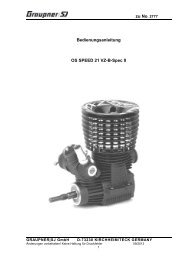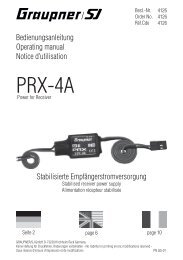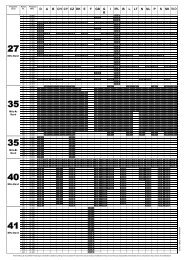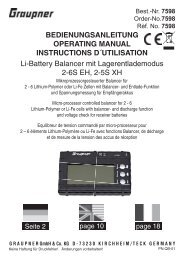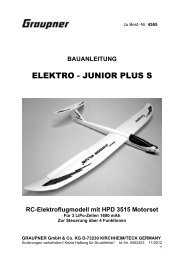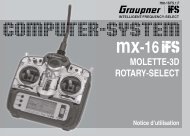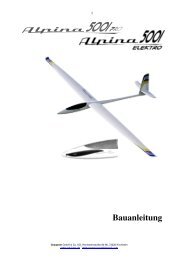You also want an ePaper? Increase the reach of your titles
YUMPU automatically turns print PDFs into web optimized ePapers that Google loves.
servos for each aileron, each with a rated torque of at least 7 kg. The wings feature<br />
machined wells for these servos. The rudder should be actuated by two servos rated<br />
at around 10 kg torque; an alternative solution is to fit one Jumbo servo for this<br />
function. The servo plate is pre-cut for two standard-size servos, but the outline of a<br />
Jumbo servo is also marked. For models of this size it should go without saying that a<br />
separate servo with a torque of at least 7 kg must be fitted for each elevator panel.<br />
The openings for these servos are pre-cut in the fuselage, but have to be trimmed to<br />
suit the particular servos you are using. We recommend the mx-22, mc-22 or mc-24<br />
radio control systems; all of these transmitters feature programs (some ready-made)<br />
which can cope with parallel linked servos (wing programs; dual mixers may be<br />
required). The easiest method of connecting servos in parallel and fine-tuning their<br />
running characteristics is to use the Magic-Box, Order No. 3162. This can be used for<br />
the rudder and ailerons if multiple servos are used for each control surface.<br />
It is very important with a model of this size that all joints involving the GRP<br />
components are really strong. This means sanding the joint surfaces thoroughly<br />
beforehand and using the appropriate adhesive. All joints should be made using<br />
epoxy laminating resin and matching accessories (thickening agents, glass cloth and<br />
tape). Do not use 5-minute epoxy except for tacking parts in place temporarily, as<br />
these adhesives are not stable at all temperatures.<br />
Building instructions<br />
Fuselage and fuselage openings<br />
Locate the marked openings in the fuselage (1) at the wing root and tailplane root<br />
positions. Cut the holes to approximate size using a rotary cutter then clean them up<br />
using a file and abrasive paper (Figs. 1, 2). Take your time over the holes for the wing<br />
joiner sleeve and tubular incidence pegs, as these sleeves need to be a smooth,<br />
sliding fit, with no hint of slop. Note that these openings are accurate reference points:<br />
if cut out exactly as marked you can be confident that the wings and tailplane will line<br />
up correctly with each other, and that the longitudinal dihedral will be correct.<br />
Cut an opening in the top of the fin as shown in Fig. 3. Fig. 4 shows the openings for<br />
the two elevator servos, which must be trimmed to suit the case size of the servos you<br />
intend to install. Use a rotary cutter or file for this. Glue small pieces of birch ply (28 x<br />
15 x 3 mm - Figs. 5, 6) on the inside of the fuselage at the servo positions to support<br />
the retaining screws as shown in Fig. 6 (bag VIII).<br />
Setting the fuselage on the main undercarriage and tailwheel unit<br />
Drill 6 mm Ø holes in the main undercarriage unit (2) at the stated spacing (Fig. 7).<br />
Place the undercarriage unit in the recess in the GRP fuselage and centre it<br />
accurately. Continue the 6 mm Ø holes through the fuselage (Fig. 8), then open up<br />
the holes in the fuselage to 7.3 mm Ø. Fit the M6 captive nuts in the holes, then<br />
secure the undercarriage unit (2) using M6 x 20 socket-head cap screws and 6.4 Ø x<br />
12.5 Ø mm washers. The undercarriage fixings are included in bag VII.<br />
Drill 5 mm Ø holes in the wheel spats (3) at the marked point (Fig. 10).<br />
Drill 5 mm Ø holes in the undercarriage unit (2) at the position stated in Fig. 9; note<br />
that this dimension is only approximate, so please check on your actual<br />
undercarriage.<br />
Install the 110 mm Ø wheels (19) using the hardware shown in Figs. 11, 12 and 13.<br />
9





